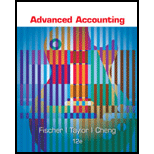
To determine:.The method, which would maintain subsidiary company as the debtor.
Introduction: Consolidation is a process in which financial statements of subsidiary is merged with financial statements of the parent. In this process, effect of intercompany transactions are eliminated.
Answer to Problem 1UTI
In both of the methods subsidiary company would continue to be a debtor.
Explanation of Solution
Parent company acquired 80% interest in subsidiary company. Subsidiary company has availed loan of $1,000,000 having ten years of maturity at an interest rate of 8%. Parent company can borrow at an interest rate of 6%.
Parent company has two options to reduce the borrowing cost of the company which are discussed as follows:
- To buy outstanding bonds of subsidiary company from open market: In this case, parent company will buy bonds from outsiders that has been issed by the subsidiary. After purchase of such bonds it will be shown as debt investment of the company. Parent would be entitled to receive interest and maturity value from subsidiary company. Therefore, subsidiary compny would continue to be a debtor.
- To lend money to subsidiary company so that subsidiary company can redeem its bonds: In this case, a fresh loan would be issued to the subsidiary for redemption of old bonds. In this case as well, subsidiary company would be required to pay interest and principal amount to the parent company. Therefore, subsidiary compny would continue to be a debtor.
Conclusion:Therefore, in both the cases subsidiary would continue to be a debtor.
Want to see more full solutions like this?
Chapter 5 Solutions
Advanced Accounting
- Nonearrow_forwardCrimson Technologies had $3,200,000 in sales for the 2023 year. The company earned 7% on each dollar of sales. The company turned over its assets 3.5 times in 2023. The firm had a debt ratio of 40% during the year. What was the return on stockholders' equity for 2023? Answerarrow_forwardAccurate answerarrow_forward
- White Co. incurs a cost of $15 per pound to produce Product X, which it sells for $26 per pound. The company can further process Product X to produce Product Y. Product Y would sell for $30 per pound and would require an additional cost of $13 per pound to be produced. The differential cost of producing Product Y is: a. $15 per pound b. $26 per pound c. $13 per pound d. $10 per poundarrow_forwardFinancial accounting problemarrow_forwardexplain properly all the answer for financial accounting question Please given fastarrow_forward
 Cornerstones of Financial AccountingAccountingISBN:9781337690881Author:Jay Rich, Jeff JonesPublisher:Cengage Learning
Cornerstones of Financial AccountingAccountingISBN:9781337690881Author:Jay Rich, Jeff JonesPublisher:Cengage Learning

